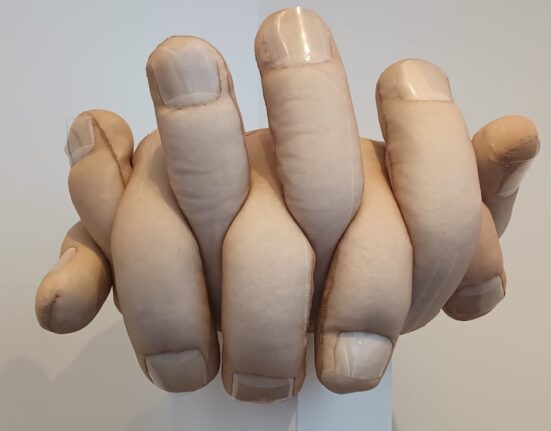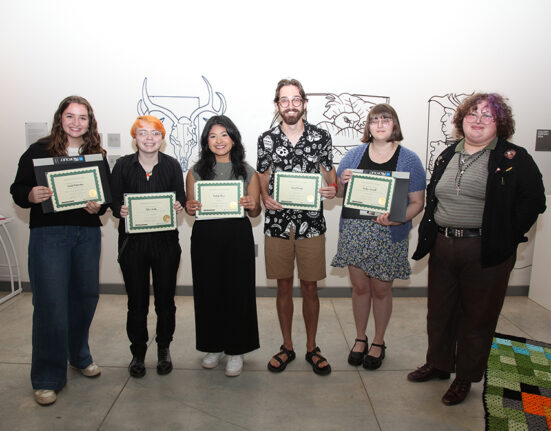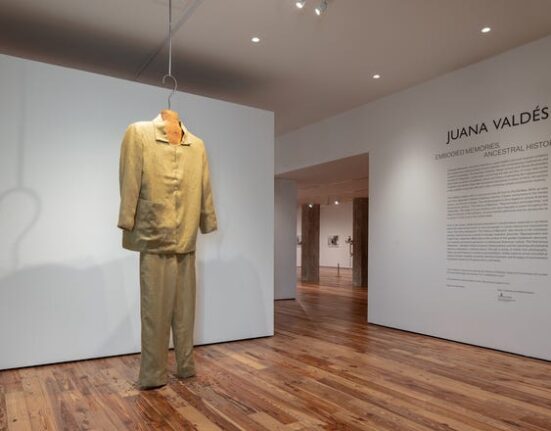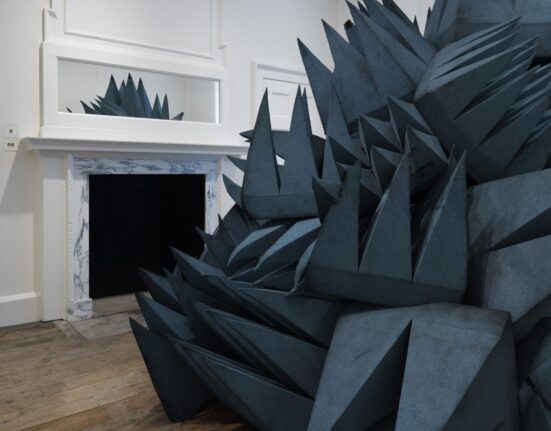You may have seen the photo before. It captures a group of 14 men and one woman clustered together in a sparse room, staring straight at the camera with scowls of varying intensity. The painter Jackson Pollock is perched on a stool in a suit and tie, holding a cigarette. Barnett Newman, seated in the front with his legs crossed, had insisted they all dress “like bankers.” This is the famous portrait of “the Irascibles,” which appeared in Life magazine in 1951. The artists pictured—including Willem de Kooning, Robert Motherwell, and Mark Rothko—would go on to be regarded as pioneers of Abstract Expressionism, a style prized for exuberant, seemingly spontaneous brushstrokes that revolutionized the art world.
For Hedda Sterne, the lone female artist in the group, the shoot was not particularly welcoming. “They were sufficiently macho to think that the presence of a woman took away from the seriousness of it all,” she later recalled. If a similar portrait was staged today, it would look quite different. For one, the artists would not all be white. Nor would they be exclusively from New York. And many would be female. Women and artists of color have been working in abstraction for as long as anyone else—they just haven’t historically been recognized by the establishment.
That’s why the new generation of female abstract artists is not discussing who can make abstract painting—Hilma af Klint began creating abstractions in the early 20th century, years before the men who got the credit. Nor are they making art explicitly about their identities as women and people of color. Instead, they are redefining what abstraction can be. The age of the Irascibles was all about the mind—minds so powerful they could create paintings that referenced nothing but themselves. That kind of solipsism is not particularly interesting now. Artists such as Rachel Jones, A’Driane Nieves, Li Hei Di, and Grace Carney see abstract painting as a place to express the power of not only the mind but also the body, spirit, and subconscious. Nathlie Provosty deploys shiny surfaces that literally reflect the viewer; Pam Evelyn assembles brushstrokes that recall the expansiveness of the seaside; and Tala Worrell incorporates in her canvases nigella seeds, sumac, and coffee grounds that evoke the textures, smells, and feelings associated with making a home. All these tactics serve to invite others into their paintings, rather than pushing them out.
Courtesy of the artist and Michael Kohn Gallery, Los Angeles.
Li’s Night Falls Like Dark Sand, 2022.
Curator Gary Garrels, who organized a blockbuster exhibition of contemporary abstract painting at Gagosian gallery in London in June, believes its resurgence coincides with a cultural moment of self-reflection. “People are turning to look more deeply inside themselves, to think about how to connect with where we are in the world today,” he says. In the past, abstract artists sought to avoid engaging with anything external. Their descendants, on the other hand, bring a profound curiosity and openness to the outside. And at a time when screens offer endless temptation and instant gratification, these artists take pride in making work that rewards extended viewing. The result is less irascible, more insightful.
The British artist Rachel Jones’s first encounter with abstraction—or, at least, abstract thinking—was when she was watching Cartoon Network as a child. Growing up in Essex, in South East England, she would see characters levitating and floating toward a pie in a window, or falling in love and having their hearts shoot out of their chests. Today she scribbles and smears oil sticks and pastels to create swirling, multicolored compositions that refer to those big emotions she saw on television. Teeth and lips are recurring abstracted motifs; Jones sees the mouth as a fertile symbol, a locus of speech, digestion, pleasure, growth, and decay. Her interest in abstraction extends off the canvas too. In September, she made her foray into opera—another highly emotional form—with Hey, Maudie, a performance at St James’s Church in Piccadilly, London. Inspired by Gwendolyn Brooks’s 1953 novel, Maud Martha, it fused poetry and classical music with jazz, gospel, and blues. “It was such a brilliant way for me to think about the things I’m concerned about in my painting,” she says. “The depth and drama of a feeling, really embodying a moment.”
After abandoning the idea of becoming an animator in her teens, Jones followed her dream of studying painting, attending the Glasgow School of Art and the Royal Academy. As a young student, she was drawn to the work of Abstract Expressionists, but says they “didn’t seem to reflect things that were close to the way that I viewed the world.” While those artists might have felt they were capturing universal experiences, Jones wanted to focus on her own, and trusted that viewers would find a way to connect. “I want to look closely at my life and the way I’m existing,” she says. “That’s the prompt for everything else.”
Courtesy of the artist, Nathalie Karg Gallery, New York, and A Palazzo Gallery, Brescia.
Provosty’s Hesperidium, 2022.
The Los Angeles–based Lebanese American artist Tala Worrell also draws from her own life for her layered abstractions, in which paint mingles with eclectic materials such as chia seeds, wood shavings from her horse’s stall, and the tiny mirrored discs that women use to accessorize abayas in the United Arab Emirates, where Worrell grew up. (Her mother is an adviser for the Guggenheim’s Abu Dhabi branch.) Worrell’s paintings are full of references to the body. Thick pours crack, wrinkle, and sag like skin. Lace slathered with paint “resembles pubic hair when you shave,” she says. Her own physical experiences find their way in. Worrell has endured chronic pain associated with her menstrual cycles; over time, she began to channel these sensations into tense, built-up mounds of paint. As egg freezing became a popular topic among her friends, oval shapes began to appear in her compositions. “Paintings are such a strange mirror for society,” Worrell says. The first thing people often ask about her works, considering their unorthodox materials, is how they are going to age. To her, it feels like a metaphor for our broader insecurities about getting older. “Paintings have always aged,” Worrell says. “It’s a reflection of the irrefutable facts of life.”
For the Texas-born, New Jersey–based artist A’Driane Nieves, painting is a way to process not society’s anxieties, but her own. After Nieves struggled with postpartum depression and bipolar disorder following the birth of her second son, her doctor suggested she pick up a paintbrush to keep her hands busy. “My therapist would tell me, ‘Trauma needs a way to move; it needs a place to go.’ Painting does that for me when I’m engaging my full body.” While pursuing a degree in social work after serving in the Air Force, Nieves gave herself a crash course in intuitive art making and Abstract Expressionism. She quickly found fans on Instagram and began devoting herself to art full-time in 2015. Three years later, she founded the Tessera Arts Collective, which promotes abstract work by female and nonbinary artists of color. Her first U.S. solo show, at the Los Angeles gallery Various Small Fires, is slated for February.
Nieves’s paintings look the way anxiety feels. Lines of color bounce to and fro across the surface of the canvas, getting tangled into knots like intrusive thoughts whizzing around in the mind. She starts her process by putting on headphones in her garage, which doubles as her studio. With Prince, Beyoncé, or Santigold in her ears, she begins dancing, tapping the canvas, and running her hands across its surface. It wasn’t until she saw one of her sons, who is neurodivergent, making similar movements that she identified her process as a form of stimming, a self-stimulating behavior common among those on the autism spectrum. Nieves maintains that if a new generation and demographic is given the opportunity, there will be endless corners of abstraction to explore. “You don’t know half of what can be expressed, communicated, or transformed through abstraction when it’s done by Black, Indigenous, queer, and Brown people,” she says.
Like Nieves, Grace Carney took a circuitous route to abstract painting. Born in Minnesota as the eldest of six siblings, she studied fashion and worked for the cool-kid clothing brand Public School before it laid off its entire staff in 2018. Two years later, she decided to go back to school to pursue her first love: art. “My paintings weren’t very good at first—I just wanted to do it so badly,” Carney recalls. Perhaps because she had been programmed to be highly attuned to trends, she was initially drawn to the Surrealist, figurative style that was popular among young artists at the time. But “it wasn’t what I wanted to make,” she says. Now large canvases covered in diaphanous color fill her Bushwick, Brooklyn, studio ahead of her first New York solo show, at P.P.O.W in February. (The gallery started representing Carney when she was right out of school, after being tipped off by a collector who had found her on Instagram.)
Taped to a wall are printouts of baroque paintings by Peter Paul Rubens, one of her favorite artists. Carney says she feels more connected to Rubens’s contorting bodies and dramatic scenes than to Abstract Expressionism, which has a propensity for flatness and machismo. “I paint about my mom—I don’t want the aggression of Ab Ex,” she says. While the familial relationships that drive her work are never explicitly rendered—at its most literal, a painting about her boyfriend’s relationship with his mother might echo the structure of a pietà—Carney believes the references lend depth, delicacy, and emotion to the compositions. “I have to put a story in there,” she says. “It doesn’t matter if someone can’t see it.”
Courtesy of © Rachel Jones, artwork photo by Ulrich Ghezzi.
Jones’s Red, Forged, 2023.
Carney isn’t the only artist who draws creative energy from embedding intimate narratives in her work like secret messages. Li Hei Di, who had a solo show at Michael Kohn Gallery, in Los Angeles, in November and is due to open another at Pippy Houldsworth, in London, in March, layers nude forms and sex scenes into her acid-hued paintings, blurring the line between abstraction and figuration. Phallic symbols come into focus as quickly as they disappear into pools of hot pink and kelly green; her work often looks like a psychedelic, orgiastic fever dream. Part of the reason for this approach is practicality. Li was born in Shenyang, China, and now lives in London; but China, where she has shown frequently, places restrictions on nudity in art. Li proudly recounts sneaking a tiny copulating couple into a large abstract composition. She has even fooled her own mother. “I was painting a giant butt plug,” Li recalls. “My mom said, ‘What a nice waterfall.’ ” Li’s influences are an eclectic mix of films, poems, and books that share the themes of love, sex, and desire. Recent inspirations include Green Snake, a 1993 Chinese film about two snake sisters who assume human form, and Breasts and Eggs, a Japanese novella about a young girl coming to terms with her changing body and her relationship with her mother.
The London-based artist Pam Evelyn did not make a conscious decision to work in abstraction, either. “I saw figuration and abstraction as the same thing,” she says. “For me, it was never a choice; it was just my nature of making.” Earlier this year, Evelyn, 27, became the youngest artist on mega-gallery Pace’s roster. She presented her first solo show—filled with large paintings, ranging from the richly textured to the confidently sparse—at its London location in September.
© Tala Worrell, Photo Courtesy of Franklin Parrasch Gallery, New York.
Worrell’s Non Perishables, 2022.
Growing up, Evelyn and her family moved roughly a dozen times around England and Scotland (“My parents were very indecisive,” she says). But they usually landed near water, and nature and landscapes are still important for her. Evelyn created several of the works in the Pace show at the storied Porthmeor Artists Residency, in Cornwall, England, in a studio overlooking Mount’s Bay. She applied paint with a spatula, only to scrape it away and flick more on top, building a kind of topographical map of her process. In other works, she left broad sections of the canvas raw, while painting other areas that evoke windows into a vibrant universe beyond.
Confidence and self-reliance are required to succeed in abstraction, a form more subjective than figuration. It often takes Evelyn months, if not years, to complete a painting, and only she knows when it’s finally done. Ahead of the Pace exhibition, she says, “I didn’t let anyone into my studio—no one.” Even her art dealers did not see many of the finished works before they arrived at the gallery for installation. “It wasn’t easy for them,” she says.
Nathlie Provosty, who was born in Ohio and is now based in Brooklyn, came to abstraction after what she described as “seven years of heavy-duty flailing, also known as exploring,” following her graduation from the Maryland Institute College of Art, in Baltimore. She tried collage, photography, sculpture, and video, but nothing felt right. In 2010, she experienced a breakthrough when she started doing automatic drawing, a practice popularized by Surrealist artists such as Salvador Dalí that involves making marks on a blank sheet of paper continuously, without a plan, to tap into the subconscious. The abstract shapes she created ended up in paintings of not-quite-symmetrical geometric forms in hues of marigold, blood red, and seafoam green. They are made with paint that is manipulated to appear matte in some places and glossy in others; unlike the hermetically sealed abstractions of the Irascibles, they intentionally bring in the viewer’s reflection. “They are very promiscuous paintings,” Provosty says.
Provosty, who will have a solo show at Miami’s Nina Johnson gallery in February, recognizes that the mainstream history of painting remains male-dominated. “We come out of a space of really subtle, internalized self-loathing as women artists,” she says. “There is a space for abstract painters who are women to undo, redo, and remake.” Provosty and her peers are not responding to this history in a literal way; they are not painting women back into the picture. Instead, they are wielding the tools of abstraction to challenge us to look more carefully and critically—at art, at history, and at everything around us.
Li Hel Di: Hair and Makeup by Nadia Altinbas at The Wall Group. Photo Assistant: Isabel MacCarthy. Pam Evelyn: Hair and Makeup by Julia Wren for Clarins and Colour Wow at Carol Hayes Management. Digital Technician: Anna Sophia John; Photo Assistant: Isabel MacCarthy. Nathlie Provosty & Grace Carney: Hair and Makeup by Amanda Wilson for Dior at Opus Beauty. Digital Technician: Charlotte Swinburn. Rachel Jones: Hair by Nat Bury for STMNT Grooming at Leftside Creative; Makeup by Lucy Burt for Dior at The Wall Group. Photo Assistant: Isabel MacCarthy; Fashion Assistant: Emeline Taverne. Tala Worrell: Hair by Nikki Providence for Unite at Forward Artists; Makeup by Yasuko Shapiro for Dior at A-Frame Agency. Photo Assistant: Benjamin Callot. A’Driane Nieves: Digital Technician: Charlotte Swinburn.







